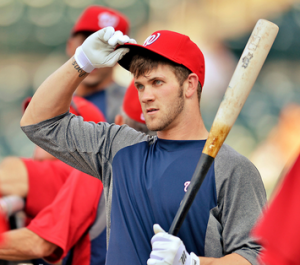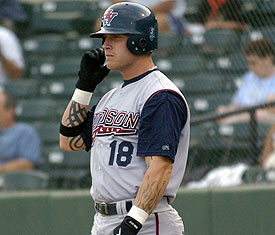 With the MLB Draft on tap this evening, it’s a good time to look at the unforgiving road to The Show.
With the MLB Draft on tap this evening, it’s a good time to look at the unforgiving road to The Show.
A little over 60 percent of first rounders make it to the big leagues—that’s a little more than half. We aren’t even talking about being an impact player, we are talking about playing in a major league game. And after that first round, the percentages slowly dip as you get deeper into every draft.
Since the time we are young ball players, we are told that with hard work and dedication, we could play in the big leagues some day. That is only about one-third truth. While hard work and dedication is helpful, many more things come into play.
You’ve heard it before—ninety percent of the players who sign professional baseball contracts will never play an inning in a major league game. That’s a staggering number. We all know that becoming a professional athlete is rare, but what is the difference between the ten percent that make it to The Show, and the ninety percent that don’t?
Think about it. That ten percent of players that make it to the bigs aren’t more talented. Maybe one or two percent are the Mike Trout’s and Bryce Harper’s of the world, but everyone else who signed a contract to play professional baseball have similar talents.
The terminology that the players are “a dime a dozen” comes to mind. Don’t get me wrong, there are varying levels of skill and ability in the areas of the coveted five tools, but for the most part, the players all trying to climb through the minor league systems have similar abilities.
The one thing that separates a guy that is going to play in the big leagues one day, from the other guys that won’t, is the mental makeup of the player. Confidence, self-assurance, intelligence, and the ability to deal with adversity are all the things that eventually separate the pack.
It’s well known in baseball circles that the jump to Double-A is what really tests the players. Why is that so? It’s because that is the level where players have to make adjustments and rely on more than just God given talent. The pitchers have to understand the art of pitching. They have to exploit the hitter’s weaknesses. They have to be able to get out of jams without relying on simply blowing a fastball by a hitter. Everyone can hit a fastball at Double-A, if they couldn’t, they wouldn’t be there.
For hitters, it’s all about how they handle adversity. As you climb through the ranks, the pitchers get better and better, and it makes it more difficult for hitters to break out of slumps. Pitch recognition, discipline, and remaining confident will be the difference for the hitter coming through the system.
And now it’s easier to see why baseball prospects can be such a crap-shoot. In the NFL, players are given a test called the Wonderlic. The prospects are given twelve minutes to answer 50 questions which are used to test the players’ mental makeup. It’s sort of an insurance policy for the team who is about to make a big investment, and a way to see if the player will be able to survive the mental rigors of being a professional athlete. Vince Young was a much more prominent player coming out of college than Ryan Fitzpatrick. But Ryan Fitzpatrick scored a perfect score on his Wonderlic and Vince Young had one of the lowest scores of all-time. Who’s still in the NFL?
 One might wonder why a test like this isn’t used when evaluating baseball players before the MLB draft. It seems logical until you take into account that the NFL draft consists of approximately 224 players, and the MLB draft often consists over 1,000 players. You can see why the MLB has probably avoided issuing the test, as it would be pretty difficult to administer the test to that many potential draftees.
One might wonder why a test like this isn’t used when evaluating baseball players before the MLB draft. It seems logical until you take into account that the NFL draft consists of approximately 224 players, and the MLB draft often consists over 1,000 players. You can see why the MLB has probably avoided issuing the test, as it would be pretty difficult to administer the test to that many potential draftees.
However, that doesn’t mean they couldn’t use some sort of test on some of the higher draft picks that get paid significant signing bonuses. Unfortunately, there may not be any test out there that can truly measure whether a player can withstand the mental rigors of professional baseball.
As if the rigors of the game of baseball are tough enough, take into account the lifestyle of a minor league player, and all of a sudden baseball doesn’t feel like a game anymore—it becomes unforgiving. Many of these young men are leaving their friends and families for the first time in their life, sometimes playing in towns and cities they have never heard of before. They ride buses for hours, sleep in motels, and barely get enough meal money to go to McDonalds twice in a day. The lifestyle can indeed be unforgiving, and many times these guys break. We read stories about prominent players being pushed to the limits by a culmination of things snowballing, and no story is more prominent than that of Josh Hamilton.
For those of you who didn’t read Hamilton’s book, he led a very sheltered life growing up. His parents often traveled with him on the road when he first broke into professional baseball. But when they stopped, he suffered through a rash of injuries, and the combination seemed to take him off the road to the show and lead him down the road to nowhere. Here we had one of the greatest talents the game has ever seen, so great in fact, that he was compared to a young Mickey Mantle. Yet even this player carved out of stone by the baseball gods themselves couldn’t handle the mental rigors of the game. He was written off as what could have been.
 I got a chance to see Josh Hamilton in his first season of professional baseball. He played a handful of games with the Hudson Valley Renegades of the NY-Penn League that year, and I was in college at the time. I had a summer job working in Dutchess Stadium (the home of the Renegades), and I remember the buzz in the crowd when Hamilton joined the team. But he got off to a horrible start, going 1/20 at the plate if I recall.
I got a chance to see Josh Hamilton in his first season of professional baseball. He played a handful of games with the Hudson Valley Renegades of the NY-Penn League that year, and I was in college at the time. I had a summer job working in Dutchess Stadium (the home of the Renegades), and I remember the buzz in the crowd when Hamilton joined the team. But he got off to a horrible start, going 1/20 at the plate if I recall.
I remember standing and talking to a co-worker and college teammate in the stands about how we weren’t impressed with Hamilton, and maybe he was going to be a bust. The crowd was rich with scouts. They were all in attendance to see the young phenom, and one must’ve overheard my friend and I speaking. He came over to us and said “Hamilton is a future hall of famer. You guys heard of Mike Schmidt right?” My friend and I said “sure.” “Well,” the scout said, “Mike Schmidt got off to a terrible start in the minor leagues too, but nobody remembers that now, do they?”
That statement from the scout always resonated with me. It was almost like he was saying that nobody gives a crap what Josh Hamilton does at A-ball, he was destined for greater things. This isn’t supposed to be a post about Hamilton, but just an example about how the mental rigors of baseball, coupled with that unforgiving lifestyle of the minor leagues is the main reason why only one in ten prospects ever play in a major league game. Luckily for Hamilton, he was so incredibly gifted, he was able to overcome all of his challenges, and used his faith in God to help conquer the mental aspect of the game.
It’s crazy to think that there are nine guys sitting on their couch that have similar talents and abilities of the guys they’re watching playing on television. The truth is, not everyone who is good enough to play professional baseball ever actually does—maybe life events take them away from the game, maybe they prefer to play some other sport, maybe they just live in some remote place and nobody ever noticed them before.
The difference between sitting at home watching the game, and playing the game on ESPN Sunday Night baseball is not much more than having the luck of being acknowledged and liked by a scout, and the ability to deal with adversity and having confidence in themselves as players. If a young prospect can master those last two things, then the sky is the limit.

Amazing Mitch. Great great job.